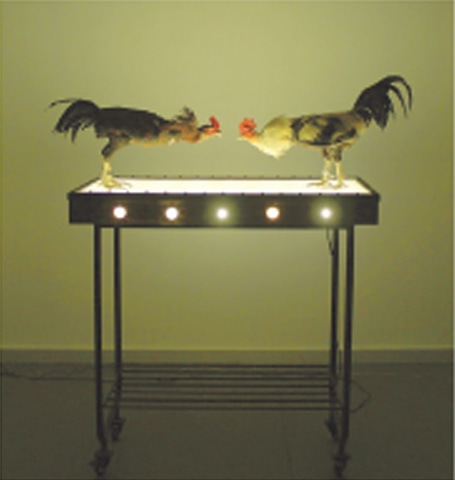
"Print is dead. Radio is dying. TV is very, very sick.” These words by Steven Barlett, chief executive officer of Europe’s largest digital publishing house, resonated within the interiors of the Canvas Gallery, Karachi. The gallery displayed new works of Aamir Habib in a show titled ‘Media is dead; long live Media!’
Habib left his home in Kohat, Khyber Pakhtunkhwa, and moved to Karachi where he graduated from the Indus Valley School of Art and Architecture in 2003. He has since participated in numerous exhibitions, both locally and internationally, where he has displayed unique works of art constantly being reinvented by technology. His practice mirrors the ever-changing state of current affairs and presents them as facetious and concise artworks.
Forms of broadcasting media are constantly evolving; print and radio have been trampled on by television, which, in turn, is now steadily losing its foothold and is made to give way to the internet. All modes have managed to keep themselves afloat, though barely but in such a fast-paced world avoiding redundancy is key. Regardless of the manner of transmission, media is the ubiquitous force surrounding humankind, creeping into lives, one home at a time. It is all knowing and all-pervasive. Habib’s work personifies media and questions its role in our lives.
Using technology and humour, Aamir Habib’s latest body of work sheds light on the ever-changing forms of the media
‘Good Cock, Bad Cock’ — a wordplay on ‘good cop, bad cop’— is an installation piece of taxidermic roosters placed on a lit tabletop. With necks stretched out and ready for battle, the scene is reminiscent of the age-old, infamous practice of cock-fighting in Pakistan. Roosters have an innate aggression towards their male counterparts and, so, placed together in a coop usually meant a fight to the death. The piece becomes a visual trope of the senseless arguments of news anchors often broadcasted, and can also describe the ‘keyboard-warriors’ of social media. These are people, much like anchors, who use aggression to incite battles behind the comfort of their computer screens. In the end, these nonsensical performances amount to nothing but vulgar entertainment.
‘Morning Delight’, a humorous sculptural piece, depicts an unusually obese, nude man staring at a smartphone while squatting. His stylised skull was comparatively small — a visual indication of insufficient brain development due to his obsession with social media, made apparent by a looped video playing on his phone. The recording read, “Like, share and subscribe.”
‘Sada Bahar’ displays a video of a surgery in progress, placed behind a life-sized hospital door, thus making the recording visible only through the door’s linear window. Watching the surgery was very much like witnessing any sort of critical event in today’s world: behind the comfort of a screen. The massive door acted like a visual barricade, much like blinkers put on horses, and directed the viewers’ attention to a specific section of the scene. Eclipsing the whole story and choosing a specific viewpoint, and often the most dramatic, has been a tool used by media forums for centuries; this installation cleverly seemed to highlight it.
Habib also took forward the technique of cell animation (drawing every frame in succession to create an animation sequence) in his work. Layering etched drawings on Perspex, he used the timely flashing of LED lights to create moving images, which subsequently were also apt interpretations of GIFs (Graphic Interchanging Format), soundless short animations commonly used in online conversations.
Habib’s playful perspective sheds light on serious issues. His pieces are finely crafted and are apt examples of his artistic dexterity. He not only depicts the present, but also relays perceptions of possible futures; in this case, what media’s role is to humanity and what form of it will retain ultimate control.
“Media is dead; Long live Media!” was displayed at the Canvas Gallery in Karachi from March 12 to March 21, 2019
Published in Dawn, EOS, March 31st, 2019
















































Dear visitor, the comments section is undergoing an overhaul and will return soon.